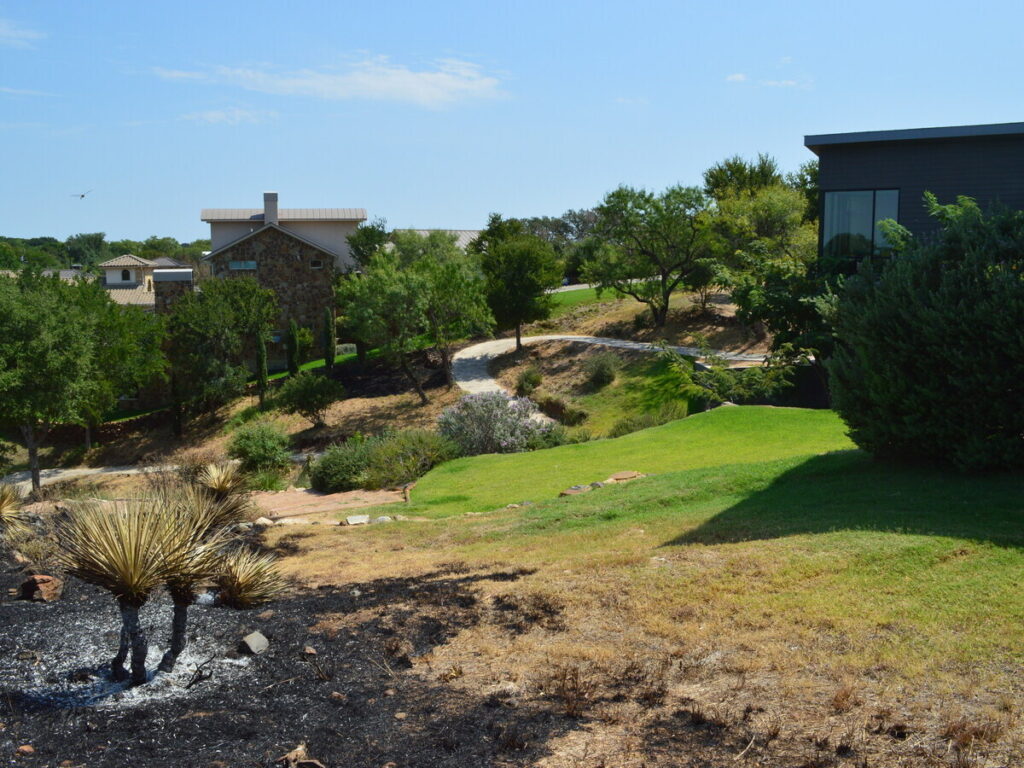Fire-resistant landscaping reduces the amount of hazardous fuels near homes or structures and selectively isolates fuels within a landscape to break up continuous areas of vegetation. It should lower the intensity of a wildfire as it approaches your home.
A healthy, well-maintained landscape is important to home and structure survival during a wildfire. The threat of wildfire does not only come from flames reaching your home, but embers traveling through the air as well.
Embers are flaming bits of debris coming from the fire that can travel one to two miles in certain weather conditions. If a large enough ember or several embers gather on flammable materials, a spot fire can occur on or near your home or structure.
Right plant for the right place
Choose the right plant for the right place rather than restrict certain plants, shrubs, and trees from your landscaping.
Fire-resistant landscaping changes the vegetation around your home to improve fire protection. All vegetation is potential fuel for a wildfire. However, the vegetation type, amount, and arrangement within the landscape can dramatically affect fire behavior and be used as a tool to improve the survivability of a structure.
Fire resistant plants
Some plants have key characteristics that make them more resistant or more susceptible to wildfires. For example, the presence of oil, resin, wax, or other chemicals in leaves and branches increase a plant’s flammability.
Factors that make them resistant to fire:
- Higher moisture content
- Drought tolerant
- Open, loose branching
- Easy to maintain and prune
- Little accumulation of dead materials
Ignition zones
The home or structure ignition zones are used to identify areas around your home to define how much vegetation they should support and different spacing considerations to implement. There are three zones: The Immediate Zone, The Intermediate Zone, and the Extended Zone.
Immediate zone
The home itself and the area 0-5 feet from the furthest attached exterior point of the home is the Immediate Zone.
This is the most important zone to take immediate action to reduce fuels as it is the most vulnerable to embers. First begin with the house itself to address structure ignitability and ember vulnerability. *Link to Fire Resistant Construction*
Then, address these landscaping concerns within the Immediate Zone to reduce ember ignition:
- Clean roofs, gutters, and attic vents of dead leaves, debris, and pine needles. Replace or repair loose or missing shingles or roof tiles.
- Install 1/8 inch metal mesh screening to attic vents.
- Repair or replace damaged or loose window screens and broken windows.
- Screen or box-in areas below patios and decks with wire mesh to prevent debris build up.
- Move flammable material like mulch, plants, and firewood piles away from wall exteriors.
- Avoid using decks and porches for storage. Remove anything currently stored underneath and keep it clean of vegetative debris.
Intermediate zone
The Intermediate Zone is made up of 5-30 feet from the furthest exterior point of the home, including any wooden attachments like a fence or deck.
Using certain landscaping and hardscaping techniques can help influence and decrease fire behavior if a fire approaches your home.
In this zone:
- Clear vegetation from under and around large stationary propane tanks.
- Create fuel breaks with driveways, walkways/paths, patios, and decks.
- Keep lawns and native grasses mowed to a height of four inches.
- Remove vegetation under trees which serve as ladder fuels so a surface fire cannot reach the crowns of trees.
- Prune trees up to six to ten feet from the ground or, for shorter trees, do not exceed 1/3 of the overall tree height.
- Space trees to have at least 18 feet between crowns with the distance increasing with the percentage of slope. Fire will travel faster uphill as flames will preheat and dry out vegetation up the slope.
- Tree placement should be planned to ensure the mature canopy is no closer than 10 feet to the edge of the home or structure.
- Limit trees and shrubs to small clusters of a few each to break up the continuity of the vegetation across the landscape. Use rocks or pavers to isolate shrubs or plant beds.
Extended zone
The Extended Zone spans 30-100 feet from the home or structure, out to 200 feet if available.
The goal of landscaping in the Extended Zone is not to eliminate fire but to interrupt the fire’s path and keep flames smaller and on the ground. This also allows for a safer environment for firefighters to work in and to defend your home.
In this zone:
- Dispose of heavy accumulations of ground litter and debris.
- Remove dead plant and tree material.
- Remove small conifers growing between mature trees.
- Remove vegetation next to storage sheds or other outbuildings.
- Trees 30 to 60 feet from the home should have at least 12 feet between canopy tops.*
- Trees 60 to 100 feet from the home should have at least 6 feet between the canopy tops.*
*The distances listed for crown spacing are suggested based on NFPA 1144. However, the crown spacing needed to reduce/prevent crown fire potential could be significantly greater due to slope, the species of trees involved, and other site- specific conditions.
